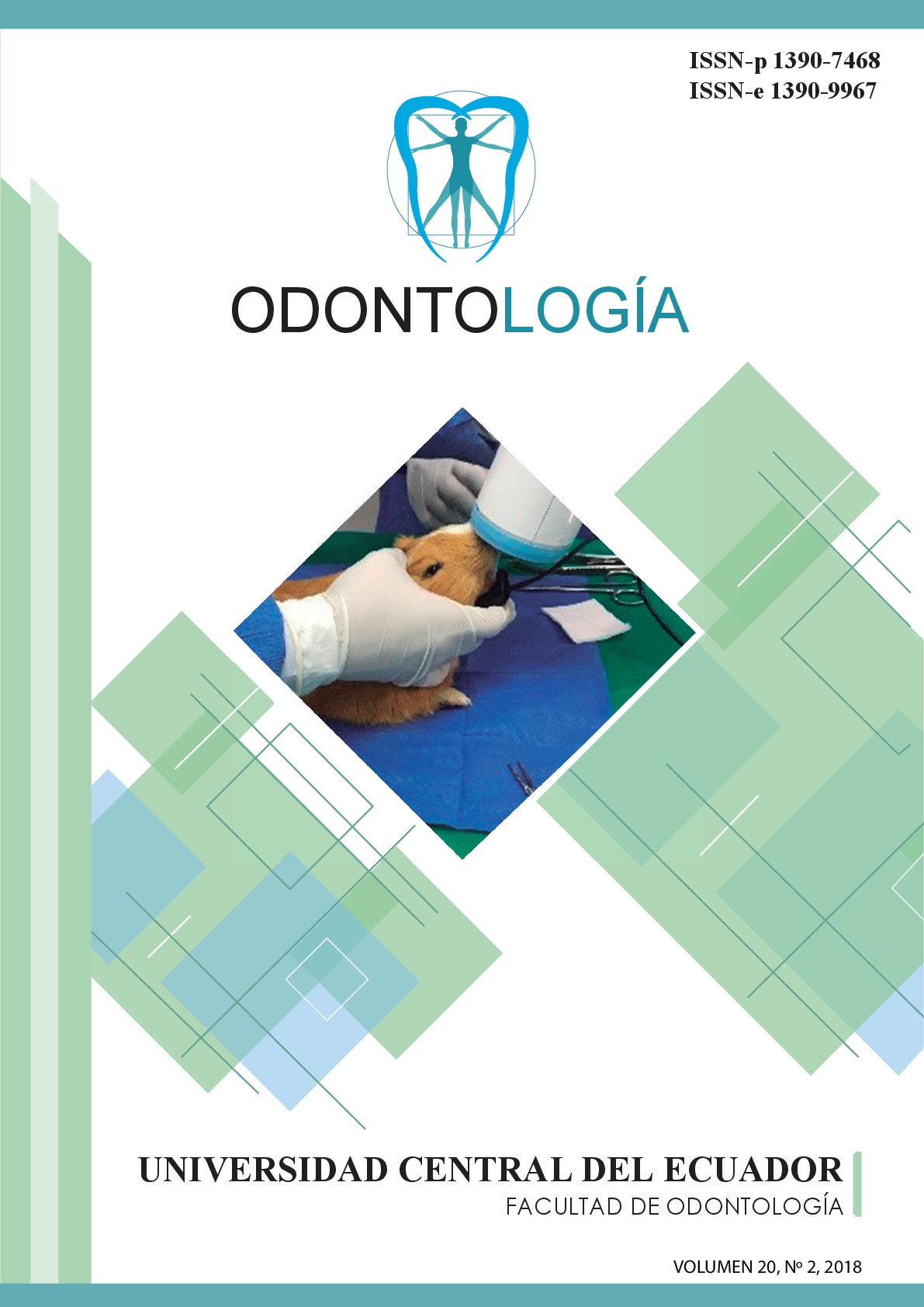Histomorfometric Study of the bone regeneration using bifasic calcium sulfate combined with alendronate in rabbits
Keywords:
Bone regeneration, Femur, Calcium sulfate, Alendronate, BisphosphonateAbstract
Alendronate is a bisphosphonate with a broad spectrum of indications whose main capacity is the inhibition of osteoclastic function. Biphasic calcium sulfate is an alloplastic graft that possesses the advantages of simple calcium sulfate as biocompatibility, osteoconductive and bioreabsorption properties. Objective: To determine the efficacy of bone regeneration through a histomorphometric study using biphasic calcium sulfate alone and combined with Alendronate. Materials and methods: 24 femurs of Andean male rabbits were used between 1.5 and 2.5 Kg, divided into 3 groups: G1 Physiological bone regeneration, G2 Biphasic calcium sulphate and G3 Biphasic calcium sulphate combined with alendronate. An incision of 2.5 cm was made to create defects of 5 mm in diameter with a depth of 1.5 mm. All the animals were sacrificed at the sixth week and histomorphometriccuts were obtained. The statistical tests of ANOVA and Tukey with a level of significance of 5% were used. Results: Bone regeneration was observed in 10.63%, 40% and 71.88% for G1, G2 and G3 respectively. A statistically significant difference was found between the groups (p <0.001). A difference was observed between G1 and G3 (p <0.001), as well as between G2 and G3 (p = 0.05), being the best results found for the G3.Conclusion: Biphasic calcium sulphate combined with Alendronate showed better bone regeneration when compared to physiological regeneration and calcium sulfate groups in rabbits.
Downloads
References
Di Stefano DA, Cazzaniga A. Injertos Óseos en las reconstrucciones pre y periimplantares. 1era. ed. Caracas Venezuela: Edit. AMOLCA; 2013; p.7
Chiapasco M, Gatti C, Casentini P, Procopio C. Manual ilustrado de Implantología Oral. 1era. ed. Madrid España: Edit. AMOLCA.; 2010; p. 291-92
Raspall G. Cirugía Oral e Implantológica. 2da. ed. Madrid España: Edit. Médica Panamericana; 2006; p. 214
Mainard D. Sustitutos óseos. Aparato locomotor. EMC. 2014; 2(47): 1 - 11.
Suarez D, Hosseini MM, Principios básicos en regeneración ósea guiada. Acta Bioclínica. 2012 2(3): 1-28.
Fernández T, Hernández GI, Alobera MA, del Canto Pingarrón M, Blanco L. Physiological bases of bone regeneration I. Histology and physiology. Med Oral Patol Oral Cir Bucal 2006;11: 47-51
López J, Alarcón M. Sulfato de calcio: propiedades y aplicaciones clínicas. Revisión Bibliográfica. Rev. Clin. Periodoncia Implantol. Rehabil. Oral. 2011; 4(3):138 - 43.
MIS Implants Technologies Ltd., n.d., Junio-2018. A través de: Google Académico. Disponible en: http://misiberica.es/wp-content/uploads/2018/06/MIS_Soluciones_Regenerativas.pdf.
Fernández T, Hernández GI, Alobera GMA, del Canto Pingarrón M, Blanco L. Physiological bases of bone regeneration II. The remodeling process. Med Oral Patol Oral Cir Bucal 2006;11: 151-7.
Guimarães M, Bueno R, Blaya M, Shinkai R, Marquez L. Influence of the local application of sodium alendronate gel on osseointegration of titanium implants. Oral & Maxillofacial Surgery. 2015; 1(44):1423-9.
Bobyn JD, Thompson R, Lim L, Pura JA, Bobyn K, Tanzer M. Local alendronic acid elution increases net periimplant bone formation: a micro-CT analysis. Clin Orthop Relat Res 2014; 472: 687-94.
Peter B, Pioletti DP, Laib S, Bujoli B, Pilet P, Janvier P, Guicheux J, Zambelli PY, Bouler JM, Gauthier O. Calcium phosphate drug delivery sistem: influence of local zoledronate release on bone implant osteointegration. Bone. 2005; 36(1): 52-60.
Harmankaya N, Karlsson J, Palmquist A, Halvarsson M, Igawa K, Anderson M, Tengvall P. Raloxifene and alendronate containing thin mesoporous titanium oxide films improve implant fixation to bone. Acta biomater. 2013; 9(6): 7064-73
Lee SJ, Oh TJ, Bae TS, Lee MH, Sho Y, Kim Bi, Kim HS. Effect of bisphosphonates on anodized and head-treated titanium surfaces: an animal experimental study. J Periodontal. 2011; 82(7):1035-42
Aspenberg P, Astrand J. Bone allografts pretreated with a bisphosphonate are not resorbed. Acta Orthop Scand. 2002; 73(1): 20-23.
Rogers MJ. New insights into the molecular mechanisms of action of bisphosphonates. Current Pharmaceutical Design. 2003;(9): 2643 - 58.
Omi H, Kusumi T, Kijima H, Toh S. Locally administered low-dose alendronate increases bone mineral density during distraction osteogenesis in a rabbit model. Bone Joint Surg. 2007;(89): 984 - 88.
Manzano-Moreno FJ, Ramos-Torrecillas J, Bertos E, Reyes C, García O, Ruiz C. Nitrogen-containing bisphosphonates modulate the antigenic profile and inhibit the maduration and biomineralization potencial of osteoblast-like cells. Clin Oral Investig. 2015; 19: 895-902.
Mathijssen N, Buma P, Hannink G. Combining bisphosphonates with allograft bone for implant. Cell Tissue Bank. 2014; 329 - 36.
Jakobsen T, Baas J, Bechtold JE, Elmengaard B, Soballe K. The effect of soaking allograft in bisphosphonate. A pilot dose response study. Clin Orthop Relat Res. 2010; 468(3): 867-74


